
E-mail: font@focusonnature.com
Phone: Toll-free in USA 1-888-721-3555
or 302/529-1876
Website: www.focusonnature.com
 |
PO Box 9021,
Wilmington, DE 19809, USA E-mail: font@focusonnature.com Phone: Toll-free in USA 1-888-721-3555 or 302/529-1876 Website: www.focusonnature.com |
A
Focus On Nature Tour
in
WESTERN and SOUTHERN
Ecuador
For Birds mostly, but also
Butterflies
and other Nature
July 6-19, 2016
Tour
with Armas Hill,
to be led by expert local Ecuadorian guides
Itinerary
follows below
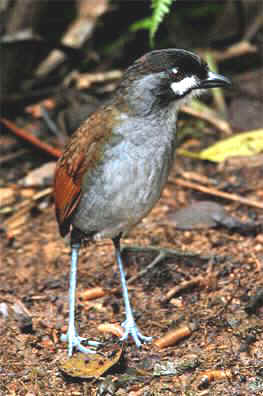
The Jocotoco Antpitta,
discovered as recently as 1997.
Only very few are known to exist.
Among the birds during this tour,
many that are regional endemics & specialties.
among groups including hummingbirds,
tanagers, tapaculos,
antpittas, other antbirds,
flycatchers, foliage-gleaners,
cotingas, conebills,
parakeets and potoos.
And many of these at special places:
in reserves that have been established
to preserve habitat and protect species.
You'll get to know these special places:
the reserves of Yanacocha, Antisana, Tapichalacha,
Utuana, Jarupe, Buenaventura.
The birds and their status
at each of these reserves are notated
in the 4-part "List & Photo Gallery of Ecuador Birds",
reached from the links below.
Links:
A List & Photo Gallery of
Ecuador Birds, in 4 Parts:
Part #1: Tinamous to Swifts Part
#2: Hummingbirds to Flycatchers
Part#3:
Antshrikes to Woodcreepers
Part #4: Vireos to Grosbeaks
Lists & Photo Galleries of:
South America Mammals
Tropical Plants
South America Butterflies, in
6 parts
South American Moths
Itinerary:
Wed, Jul 6:
Arrival in Guayaquil, Ecuador. Overnight in
Guayaquil.
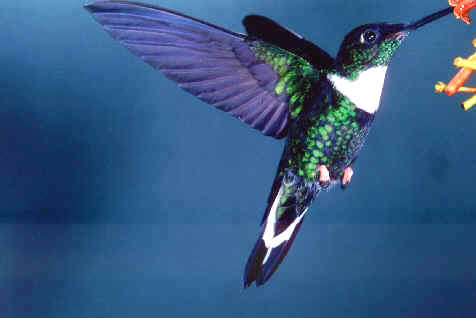
One of the
great assortment of hummingbirds in Ecuador,
the Collared Inca,
one of a number of hummingbirds
that should be seen during this tour.
Thu Jul 7:
From Guayaquil, we'll drive south
to our first destination for birds and other nature, the reserve at Churute,
an area with mangroves and forest.
In the mangrove area, we should see a large bird called the Horned Screamer.
Churute is the only place west of the Andes where that species occurs.
Among the birds in the forest, possibilities include: Gray-cheeked Parakeet,
Red-billed Scythebill, Jet Antbird, Pacific Royal Flycatcher, Pacific
Elaenia, and Black-and-white Tanager (rare).
Other birds in this region of western Ecuador include: Snail Kite, Croaking
Ground Dove, Pacific Parrotlet, Short-tailed Field Tyrant, Snowy-throated
Kingbird, Parrot-billed Seedeater, and Saffron Siskin.
South of Churute, we'll stop at a place where yet some birds can be found, some
localized species in the region. These include: Crimson-breasted Finch,
Black-lored Yellowthroat, Large-billed Seed Finch.
Overnight in the small city of Machala.
Fri Jul 8: In the morning. we'll go
south to a wetland that we visited during one of our previous tours in the area, and
where we found some wonderful birds, including: Spotted Rail, Southern
Pochard, Comb Duck, many whistling ducks, Pinnated Bittern, Spotted Rail,
and a Great Grebe (a mega-rarity for Ecuador). Many other birds
were there as well.
"Just down that road" we'll go to a place for the Rufous-necked
Wood Rail.
In the afternoon, we'll head east, ascending from the coastal lowlands to the Umbrellabird Lodge
in the Buenaventura Reserve. Along the way, we'll be birding, among other places, in an excellent
deciduous forest near El Empalme.
Overnight at the Umbrellabird Lodge.
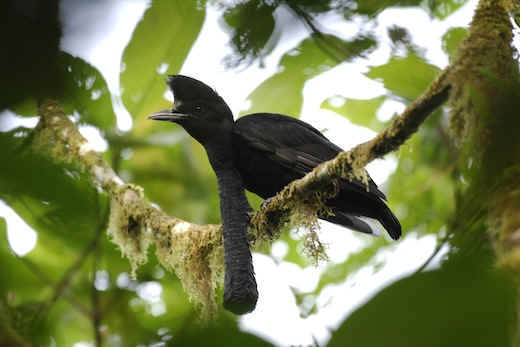
Two species of birds that are
specialties of Buenaventura
are the Long-wattled Umbrellabird (above),
and the El Oro Parakeet (below).
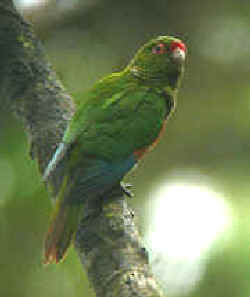
Sat &
Sun, Jul 9 & 10:
Particularly notable among the birds at Buenaventura are the
El Oro Parakeet and
El Oro Tapaculo. Also in that area are species of both the Choco and Tumbesian
regions,
including these:
Rufous-headed Chachalaca, Gray-backed Hawk, Ochre-bellied Dove, Pacific Royal
Flycatcher, and Ochraceous Attila.
Close to the research station is a lek of the threatened Long-wattled
Umbrellabird.
Different types of feeders are near the lodge for birds and mammals, where a
wonderful variety of hummingbirds and tanagers can be see. Also among the birds,
toucans. Among the mammals, coatis. Overnights at the Umbrellabird Lodge.
The Buenaventura Reserve was established in
1999 to protect the locality where the El Oro Parakeet was discovered in
1980.
By the 1990s, the forest there had been substantially reduced, becoming
ever-larger pastures. Almost all of the large trees were removed.
The reserve was created in just the nick of time. Its size has increased, from
400 hectares to about 2,000 hectares by 2011. The altitude ranges from about 400
meters to over 1200 meters above sea level. It now protects one of the largest
tracts of foothill cloud forest that remains on the west slope of the Andes in
southwestern Ecuador.
In the reserve, there is a combination of elements of deciduous Tumbesian
Forest (of southern Ecuador & northwester Peru) and the wet Choco
Forest (of northwestern Ecuador).
More than 330 species of birds have been found at Buenaventura.
A dozen are classified as globally threatened, and about another 35 are local
endemics.
Among the globally threatened species are the Gray-cheeked Parakeet and,
as noted above, the Pacific Royal Flycatcher and Long-wattled
Umbrellabird.
The Gray-backed Hawk can be rather easily seen.
Many of the 31 species of hummingbirds that have been recorded can be
seen at the feeders at the lodge. In trees around the lodge, Choco Toucans
are often seen.
At a higher altitude of around 800 meters, it is the zone of the El Oro
Parakeet. The Buenaventura Reserve hosts
about two-thirds of the presently known global population of the species,
currently from 150 to 200 individuals. The number has steadily been increasing
due to a successful nestbox campaign designed to supplement the scarcity of
suitable nest-trees.
Among other rare birds in the lush cloud forest, perhaps the most notable is the
El Oro Tapaculo that was discovered there in 1985. Its population is thought
to be a few dozen pairs at most, and the species is no longer known to occur
anywhere else in the world.
Mammals at the Buenaventura Reserve
include the Hoffmann's Two-toed Sloth, the Northern Tamandua
(a species of arboreal anteater that in South America would be better called the
Western Tamandua), and a wild cat called the Oncilla. A
larger wild cat, the Puma, also occurs in the reserve.
Also there are Mantled Howler Monkeys, and a program has been underway to
re-introduce the White-fronted Caphuchin, a critically-endangered species
in Ecuador that was hunted out in the Buenaventura area in the
1990s.
As to reptiles and amphibians, brightly-colored
"poison-arrow" frogs are numerous at times along small streams,
and one new species of lizard has been discovered in the reserve.
When the sun shines at Buenaventura,
slow-flying Morpho butterflies appear, and there are many other
butterflies to be seen.
The cloud-forest trees have abundant epiphytes and many orchids.
A major reforestation program has been underway at
Buenaventura. Recovery has been quite noticeable. Near the Umbrellabird
Lodge, where pastures were, there is now closed-canopy
woodland.
So, in addition to seeing some "good birds", there is something else
good to see: a tropical environment that has been
recovering.
Mon, Jul 11: This day, we'll continue
further south in Ecuador, with birding along the way, to the Tapichalaca Reserve.
Birds, along the way, could include Bearded Guan, Red-hooded Tanager,
Band-tailed Sierra Finch, Tumbes Sparrow, and Gray-breasted
Mountain-Toucan.
Upon our arrival at the Tapichalaca Reserve, we'll first be impressed by the
presence of many hummingbirds at the feeders. Among them: Amethyst-throated
Sunangel, Chestnut-breasted Coronet, Collared Inca, Flame-throated Sunangel,
and Long-tailed Sylph.
Overnight at the Casa Simpson at Tapichalaca.
Tue & Wed, Jul 12 & 13:
We'll be these 2 days at the Tapichalaca
Reserve of the Jocotoco Foundation, for 2 full days. The reserve was
established in 1998 to protect the habitat of the Jocotoco Antpitta, a
species whose total population has remained at about 12 pairs since the species
was discovered at Cerro Tapichalaca in 1997.
We will spend a full day birding the trails of Tapichalaca, starting with the Jocotoco
Antpitta worm feeder. In addition to the Jocotoco Antpitta, other
interesting birds that we'll have a chance to see are the Chestnut-naped
Antpitta, Orange-banded Flycatcher, White-throated Quail-Dove, and White-capped
Tanager. Overnights again at Casa Simpson.
The Tapichalaca Reserve is located in the Zamora-Chinchipe
Province just east of the
Continental Divide on the east, or Amazonian, slope of the Andes, adjoining the
southern portion of the Podocarpus National
Park, and only a short distance north of the Peruvian frontier.
The size of the reserve is about 8,500 acres, and its altitude is from 1800 to
3400 meters above sea level. Much of it, at an altitude of 2200 to 2900 meters,
is montane cloud forest. Temperatures are typically in the range of 10-20
degrees C.
The lower part of the reserve is subtropical Andean forest where temperatures
are in 20-30 degree C. range.
In 2004, the reserve was extended on the west side of the Rio Valladolid/Rio
Tapichalaca drainage. The new sector has been named the Christopher
Parsons Forest in memory of the producer and director of the famous
"Life on Earth" television series presented by David
Attenborough.
In 2009, the nearby Yacuri National Park was
created, extending protection of the higher elevations in the area from the Podocarpus
National Park all the way to the Peruvian border. This very remote
area is now well buffered by the Tapichalaca Reserve,
with all of the region containing an exceptionally rich and almost totally
undisturbed montane forest, one of the finest in all of South America.
This large, and now protected area is rich in species, with a high proportion
of regional endemics with a very small geographic range. This applies of
course to the birds, but also to mammals, amphibians and reptiles,
and plants.
A survey of the amphibians and reptiles has found 34 species, of which 70
per cent are endemics, and about 50 per cent considered globally threatened. The
Tapichalaca Tree Frog, Hyloscirtus tapichalaca, was discovered in 2001, and
is not known to occur anywhere. Even in the reserve, it is known to be only a
few sites. Research is also underway relating to some other potential new
species.
Over 130 species of plants at Tapichalaca
are classified as endemics, and as many as 90 per cent of them are designated in
the Red Data Book as threatened.
Orchids are particularly abundant, with several hundred species, nearly
all of them epiphytes.
One species, Bomarea longipes, was "lost" for nearly 130 years,
but was then rediscovered in 2004 on the Cerro (ridge) Tapichalaca. That species
had previously been known only from the first specimen found in 1876.
Remarkably, that plant was rediscovered at the exact same site.
As to mammals, the forest at Tapichalaca
supports important populations of the Mountain (or Woolly) Tapir
and the Spectacled Bear, although it must be said that neither are easily
seen.
Other threatened mammals include 7 vulnerable and 4 near-threatened species.
Among such mammals, Puma, Andean Paca, Northern Pudu (a very small deer),
and Andean Coati have all been seen close to the lodge where we will
stay.
And here now, some more about the birds: the Tapichalaca
forest is home to tremendous variety of Andean species, with
more than 300 occurring regularly in, or immediately adjacent to the
reserve.
Mixed flocks are a notable feature. And the species are of different
species up and down the slopes. Of particular interest are the tanagers.
Perhaps there is no other place with more of the gaudy, jay-like White-capped
Tanager.
Dozens of hummingbirds constantly zoom around the feeders (as mentioned
already).
13 species of birds are globally threatened or near-threatened. Among them, in
addition to the Jocotoco Antpitta and some other species noted
above, there are these:
Golden-plumed Parakeet, White-breasted Parakeet, Coppery-chested
Jacamar, and Imperial Snipe, Masked Mountain-Tanager, Peruvian
Antpitta, Greater Scythebill, Neblina Metaltail, and Masked
Saltator.
In the Tapichalaca area, particularly in the Quebrada
Honda section, there were historically some magnificent stands of Podocarpus
trees. But from 1950 to 2000, most of them were removed due to their high
value as timber.
A very small number remain, but a positive note is that young trees are
appearing naturally in the forest, although most are still not very high. Such
natural regeneration is a part of the forest ecosystem, but also since 2005,
there has been an active program with a large number of native tree seedlings
being planted and growing in old pastures where the natural regeneration has
been at a slow rate.
A special thing for us at Tapichalaca is the
worm-feeder in the forest for the Jocotoco Antpitta. That feature of the
place was implemented so that visitors, who stay as we will be in the reserve,
can have close-up views of a habituated pair of the birds, and usually their
offspring, and sometimes one or two other antpitta species.
Prior to this innovation, it was almost always necessary to use "tape
play-back" to obtain a view that was not always satisfactory of a
territorial bird.
An unexpected bonus of this program has been that the abundance of food for this
pair (as they are fed daily) has resulted in no less than 7 fledged birds in
about 3 years, about double the expected productivity.
So, it can be an incredible show, with the very rare Jocotoco Antpitta
literally at our feet!
Thu &
Fri, Jul 14 & 15:
We'll travel to Macara, with
birding along the way where we see some interesting birds of the Tumbesian
area, including Elegant Crescentchest, Loja Hummingbird, and Parrot-billed
Seedeater.
We'll be birding this day in the amazing forest of the Utuana
Reserve.
Birds at Utuana include montane Tumbesian endemics, including: the Jelski's
Chat-Tyrant, Gray-headed Antbird, Rufous-necked
Foliage-gleaner, Piura Hemispingus, Bay-crowned Brush-Finch, and Black-cowled
Saltator.
The Utuana Reserve, also known as the "Bosque
de Hanne", was established in 2001 to protect one of the last
remnants of humid highland forest in southwestern Ecuador. In it, are several
bird species with highly restricted ranges (noted in the previous paragraph).
The reserve was established in many of Hanne Bloch for her efforts to protect
the last forests in southwestern Ecuador. She studied at the University of
Copenhagen from 1989 to 1991, under the guidance of Jon Fjeldsa, the author and
illustrator of the book, "Birds of the High Andes", published in 1990.
Hanne's work included the mapping of remaining forests and the cataloging of
their wildlife in the southern Ecuadorian highlands near Loja. That work
continued until her tragic death in a plane accident in 1998.
Before Utuana became a reserve, much of the
forest in the area had been removed, and what remained was disappearing fast.
The land that is now a reserve was owned by a community of about one hundred
families who depended on the forest for fuel and wood. The Jocotoco
Foundation worked closely with the community, and the reserve came to
be. Although it is small, only about 500 acres, it is an important remnant of
tall forest with old moss-covered trees and dense thickets of Chusquea bamboo.
Located in a generally dry region of Ecuador, Utuana
gets much of its moisture from low-lying clouds.
Utuana serves as an example that it is
sometimes necessary to establish a reserve to protect very rare species or a
unique habitat even if the protected area is small.
Two wonderful hummingbirds that regularly visit the feeders at Utuana
are the Rainbow Starfrontlet and the Purple-throated Sunangel.
Both are generally scarce hummingbirds with small and quite patchy
distributions.
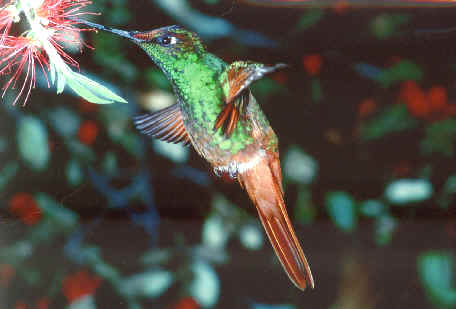
Rainbow Starfrontlet
Traveling from the Utuana to the Jorupe Reserve, among the giant ceiba
trees, we may see White-headed Brush-Finch, Tumbes Hummingbird,
and Baird's Flycatcher.
Overnights at the Urraca Lodge in the Jorupe
Reserve.
Sat &
Sun, Jul 16 & 17:
At the Jorupe Reserve in the Tumbesian
region of southwestern Ecuador, we'll be birding in deciduous forest
for what are called the "Tumbesian endemics" unique to that
region.
Among the birds in that category, these: Gray-cheeked Parakeet,
Gray-breasted Flycatcher, Loja Tyrannulet, Slaty Becard, Watkins Antpitta,
Blackish-headed Spinetail,
Henna-hooded Foliage-gleaner, White-edged Oriole, Black-capped
Sparrow, and, as darkness falls, the West Peruvian Screech Owl.
Jorupe is a very good place to see King Vulture. Overnights at the Urraca Lodge.
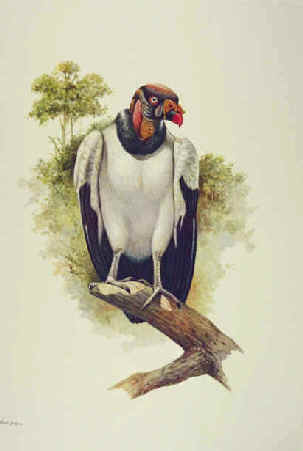
King Vulture
Opened in August
2009, the Urraca Lodge was built at a small
clearing at the top of a ridge looking down the Jorupe Valley towards the
mountains in Peru in the distance. Nowhere else is it possible to stay overnight
in a Tumbesian dry tropical forest.
Almost all of the Tumbesian endemic bird species in the reserve can be
seen daily from the lodge, including the attractive White-tailed Jays
after which the lodge is named.
The lodge has a centrally located dining room surrounded by open porches for
viewing wildlife. A trail leads to the cabins in the forest, each with a
spectacular view of the valley.
The reserve has an extensive trail system through a number of different habitats
and yet a few other habitats are readily reached by
road.
Mon, Jul 18:
Early in the morning, we'll do some final birding in the Jorupe
Reserve, in
the garden by the nearby road. Afterwards, we go on that road, and a few others,
back to the Ecuadorian coastal lowlands, where we'll overnight, as we did
earlier during the tour, in Machala.
Tue, Jul 19:
Travel in the morning from Machala to the Guayaqui airport, for our
departure for home from Ecuador.
Price, in US dollars,
based on double occupancy:
| $2,945 Single supplement: $375 |
Price includes:
All overnight accommodations
in comfortable hotels/lodges
Meals, except those on Jul 6 & 19
Land transportation
Entrance fees to reserves
Expert bilingual birding guide in addition to FONT leader
Price does not include:
International flights to/from
Ecuador
Airport departure tax (if required)
Meals on Jul 6 & 19
Items of a personal nature, such as extra drinks, alcoholic beverages, snacks,
laundry, phone calls
A deposit of
$500 will assure a
place on the tour.
![]()